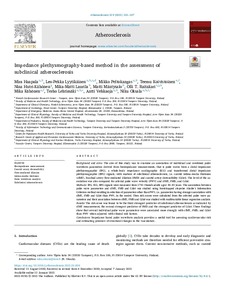Impedance plethysmography-based method in the assessment of subclinical atherosclerosis
Hutri-Kähonen Nina; Kähonen Mika; Lehtimäki Terho; Lyytikäinen Leo-Pekka; Oksala Niku; Vehkaoja Antti; Peltokangas Mikko; Laurila Mika-Matti; Raitakari Olli T; Koivistoinen Teemu; Haapala Mira; Mäntysalo Matti
Impedance plethysmography-based method in the assessment of subclinical atherosclerosis
Hutri-Kähonen Nina
Kähonen Mika
Lehtimäki Terho
Lyytikäinen Leo-Pekka
Oksala Niku
Vehkaoja Antti
Peltokangas Mikko
Laurila Mika-Matti
Raitakari Olli T
Koivistoinen Teemu
Haapala Mira
Mäntysalo Matti
ELSEVIER IRELAND LTD
Julkaisun pysyvä osoite on:
https://urn.fi/URN:NBN:fi-fe2022012711079
https://urn.fi/URN:NBN:fi-fe2022012711079
Tiivistelmä
Background and aims
The aim of this study was to examine an association of individual and combined pulse waveform parameters derived from bioimpedance measurements, that is pulse waves from a distal impedance plethysmographic (IPG), a whole-body impedance cardiographic (ICG) and transformed distal impedance plethysmographic (tIPG) signals, with markers of subclinical atherosclerosis, i.e. carotid intima-media thickness (cIMT), brachial artery flow-mediated dilation (FMD) and carotid artery distensibility (Cdist). The level of the association was also compared for arterial pulse wave velocity (PWV) and cIMT, FMD, and Cdist.
Methods
IPG, ICG, tIPG signals were measured from 1741 Finnish adults aged 30-45 years. The association between pulse wave parameters and cIMT, FMD and Cdist was studied using bootstrapped stepwise Akaike's Information Criterion method resulting in selection of parameters other than PWV, i.e. parameters having stronger association with cIMT, FMD and Cdist than PWV, in the model. Then risk scores were calculated from the selected pulse wave parameters and their association between cIMT, FMD and Cdist was studied with multivariable linear regression analysis.
Results
The risk score was found to be the third strongest predictor of subclinical atherosclerosis as indicated by cIMT measurement, the second strongest predictor of FMD and the strongest predictor of Cdist. These findings show that several individual pulse wave parameters were associated more strongly with cIMT, FMD, and Cdist than PWV when adjusted with clinical risk factors.
Conclusions
Impedance based pulse waveform analysis provides a useful tool for assessing cardiovascular risk and estimating presence of structural changes in the vasculature.
Kokoelmat
- Rinnakkaistallenteet [19207]
